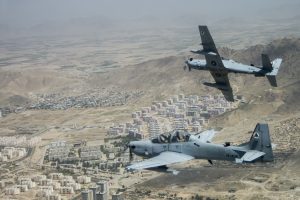As the erstwhile Afghan Republic collapsed in mid-August 2021, dozens of planes and helicopters took off from the airfield at Mazar-i-Sharif. The harrowing final flights of the Afghan Air Force took them, ultimately, not to Kabul but across the border to Termez, Uzbekistan.
Three years later, the 46 Afghan aircraft that made the flight to Uzbekistan are reportedly finally being transferred to Uzbek authorities. Of the aircraft that landed in Uzbekistan, 22 were small fixed-wing aircraft, like A-29s (also called Super Tucanos), and 24 were helicopters, mostly Mi-17s, but also UH-60 Black Hawk and MD-530 helicopters. Among the fixed-wing aircraft were six PC-12 single-engine passenger and light-cargo aircraft.
“This equipment was never Afghan, it was American. [The Afghan Republic’s military] used it, but we have always been the owners,” U.S. Ambassador to Uzbekistan Jonathan Henick told Kun.uz. When asked about the fate of the aircraft, Henik responded, “It will be in Uzbekistan. Yes, it is already official.”
Henik’s comment comes a few weeks after news broke that a Colorado-based aerospace and defense company, Sierra Nevada Co., had been awarded a $64.2 million contract to repair six PC-12s. On August 9, the U.S. Department of Defense published a list of contracts, which included the PC-12 deal. The announcement notes, “Work will be performed in Uzbekistan and is expected to be completed by Aug. 7, 2027. This contract involves Foreign Military Sales to Uzbekistan.”
Although repair of the A-29s is not mentioned, it is worth noting that Sierra Nevada Co. partners with Embraer on the production of A-29s in the United States. In 2018, the company was contracted to build up Afghanistan’s A-29 fleet. (At the time, that work was slated to be completed by December 2024.)
The Taliban government in power in Kabul has consistently pushed back against the transfer of the Afghan aircraft to Uzbekistan, as well as the transfer of a small number of aircraft that landed in Tajikistan to Dushanbe.
The Taliban’s acting Defense Minister Mohammad Yaqoob in January 2022 warned the Uzbek and Tajik governments of “consequences” if they did not surrender the aircraft to Afghanistan. Later that year, in September, he somewhat softened his tone when it came to the Central Asian governments, but reiterated the Taliban’s claim that the aircraft belong to Afghanistan.
Yaqoob said at the time, “[The governments of Tajikistan and Uzbekistan] say that the issue is that the Americans don’t let us transfer these helicopters back to Afghanistan. We have spoken with Americans about it and informed them that they belong to the nation, and it is Afghanistan’s right, not someone else’s personal property. As a result, it ought to be returned to Afghanistan.”
According to a report from Tolo News, after Henik’s comments regarding the fate of the aircraft in Uzbekistan, the spokesman for the Taliban’s Ministry of Defense, Enayatullah Khwarazmi, strongly objected to the plan in an audio statement.
“The Ministry of Defense clearly declares that the United States has no right to donate or confiscate the property of the Afghan people. The government of Uzbekistan is expected to refrain from any dealings in this regard, to consider good neighborly relations, and to make a wise decision by cooperating in the return of Afghanistan’s air force aircraft,” he said.
For its part, the Uzbek government, while engaging diplomatically with the Taliban on matters of trade and transit, has maintained the argument that the aircraft in question belong to the United States. Despite the Taliban government’s insistence that Tashkent should return the planes to Afghanistan, that seems extremely unlikely.
In a May 2022 interview, Uzbek President Shavkat Mirziyoyev’s special representative on Afghanistan, Ismatulla Irgashev, told VOA, “The U.S. government paid for them… It funded the previous Afghan government. So, we believe it is totally up to Washington how to deal with them… We’ve kept this military equipment in agreement with the U.S. and have told the Taliban so.”
The bulk of the existing Uzbek Air Force is comprised of Soviet or Russian aircraft. According to Flight Global’s 2024 World Air Forces directory, the Uzbek Air Force fields 38 MiG-29s, 20 Su-27s and 13 Su-25s. In regard to combat helicopters, Uzbekistan fields 100 in total, 40 of which are reportedly Mil Mi-8s. When it comes to transport aircraft, Uzbekistan has 13 active planes.
The refurbishment and return to service of the six PC-12s, in particular, will expand the Uzbek Air Force’s capabilities. However, the fact that the Afghan planes are not of Soviet or Russian origin like the rest of the fleet may pose maintenance challenges; put another way, they present an opportunity for U.S.-Uzbek military cooperation.

































